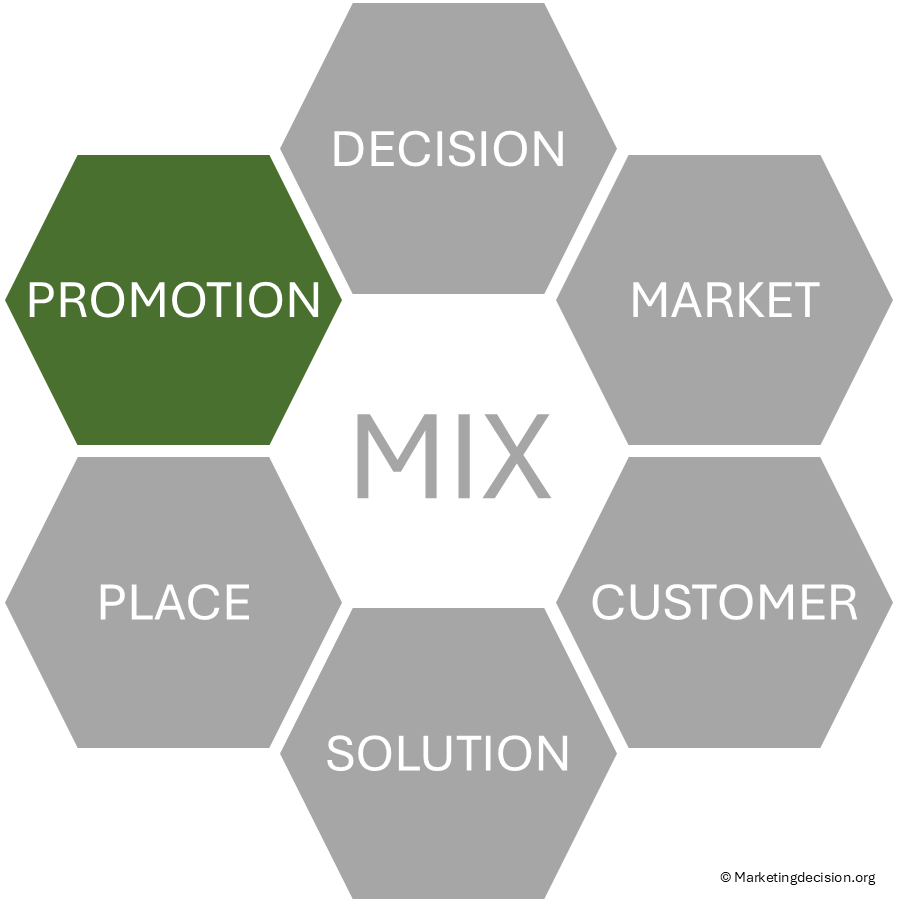
The Marketing Mix, first introduced in the early 1960s, defined Promotion as one of the four P’s — Product, Price, Place, and Promotion.
Over time, some marketers adopted the term Communication, emphasizing a two-way dialogue with customers rather than a one-directional “push” message. This shift also aligned with the growing customer-centric mindset, as the “C” in Communication echoed the “C” in Customer.
With the rise of new media and digital channels, including social networks, promotion has evolved dramatically. Yet, the word Promotion remains precise and action-oriented. It reminds marketing teams to focus on effectiveness and measurable outcomes rather than terminology. For this reason, this site continues to use promotion while fully embracing its communication dimension.
For background on the marketing mix, you can read this article on Wikipedia: https://en.wikipedia.org/wiki/Marketing_mix
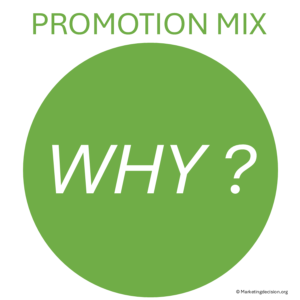 Promotion in marketing refers to how companies communicate value and intent to their audiences — informing, persuading, and reminding customers about products, services, or ideas. It represents the most visible part of marketing, where strategy meets communication and value is transformed into perception.
Promotion in marketing refers to how companies communicate value and intent to their audiences — informing, persuading, and reminding customers about products, services, or ideas. It represents the most visible part of marketing, where strategy meets communication and value is transformed into perception.
In the marketing mix, promotion plays a dual role. On one hand, it amplifies visibility, ensuring that offerings are recognized and understood. On the other, it translates positioning into action, connecting the company’s message to real customer motivations. Whether through advertising, public relations, direct communication, or digital platforms, the objective remains the same — to build a meaningful bridge between the company and its markets.
A well-defined promotion strategy aims to build awareness, generate interest, and guide potential buyers through their journey — from initial curiosity to adoption and loyalty. When done effectively, promotion not only influences individual purchase decisions but also strengthens long-term brand credibility and customer relationships.
Ultimately, promotion represents the voice of marketing — the means through which companies express their value in ways that customers can see, hear, and remember.
Although promotion and communication are often used interchangeably, their connotations differ slightly:
Promotion focuses on speaking up — ensuring that the right messages reach the right audiences at the right time.
Communication emphasizes listening and dialogue — building relationships and engagement.
In practice, both perspectives are essential. Modern marketing relies on integrated marketing communication (IMC): coordinating advertising, digital campaigns, PR, and direct marketing so that every touchpoint conveys a consistent brand message.
Understanding this distinction helps marketers define clearer objectives when evaluating which promotional programs deserve investment.
When developing promotional programs, several strategic questions help clarify purpose and investment priorities:

Why should we invest in specific promotional activities, and what needs or objectives are we addressing?
What is the Return on Investment (ROI) for each program?
Are promotion budgets aligned with target segments and growth priorities?
Who decides on these budgets, and how are they allocated?
Which activities deliver the best returns at lower costs?
Asking these questions ensures that marketing and sales leaders remain accountable for performance and resource allocation.
One of marketing’s most creative roles is naming. Without a name, a product or concept remains internal and invisible. Assigning a name gives it identity — turning an idea into a recognizable brand. Every name carries the promise of meaning, differentiation, and memorability.
Both dimensions — brand creation and sales enablement — show how promotion connects strategic identity with operational impact.
Promotional activities are crucial in supporting sales teams. They enable outreach through channels that sales representatives cannot always access directly — for example, social media, PR, or online advertising.
Customers typically move through several stages before buying: awareness, interest, evaluation, selection, purchase, and use. Promotion plays a central role in the early phases, especially awareness and interest, where communication can influence perception long before a purchase decision.
Because customers are often more open to learning outside an active buying cycle, effective promotion creates familiarity and prepares the ground for successful sales engagement.
 The “Why, What, and How” framework is a powerful way to structure marketing discussions — especially in promotion and communication.
The “Why, What, and How” framework is a powerful way to structure marketing discussions — especially in promotion and communication.
The Why clarifies purpose and needs.
The What defines objectives and messages.
The How explains methods, channels, and execution.
Using this framework ensures that everyone involved — from marketing to sales to management — shares a common language. It helps link strategic intent to operational decisions, improving clarity and collaboration.
This structured approach lays the groundwork for prioritizing budgets and coordinating communication plans effectively.
Beyond the frameworks and questions, understanding how promotion and communication complement each other helps position marketing as both a voice and a listener in the market. When naming this section of the marketing mix, two words stood out: promotion and communication.
Both are essential, yet they emphasize different aspects of the same mission — to connect companies with their audiences.
While promotion highlights expression and reach, communication adds depth through dialogue and feedback. Together, they form the foundation of modern customer engagement, where continuous adaptation to new channels and behaviors is key.
To explore further, see:
If priorities are unclear, start by revisiting the purpose of each activity.
Well-defined objectives make it easier to assess performance and allocate future budgets intelligently.
By starting with the Why, companies align motivation with real business goals, ensuring that promotion investments strengthen both short-term impact and long-term positioning.
Most organizations rely on multiple channels — public relations, digital marketing, promotional events, and merchandising, among others.
Each plays a distinct role in reaching audiences. A comprehensive communication plan helps coordinate these initiatives, ensuring consistency and efficiency.
Before designing such a plan, it is useful to:
Clarify why it is needed.
Define success indicators.
Identify key questions, such as:
How can we increase brand visibility?
Which channels best reach our target audiences?
How can communication enhance the customer experience?
How can marketing activities contribute to profitability?
Organizing communication in this way turns what could be a series of isolated efforts into a coordinated, measurable program aligned with company priorities.
A well-prepared communication plan thus links strategy, structure, and measurable performance — ensuring that promotion truly serves business priorities.
Communication and promotion have evolved profoundly since the early days of the marketing mix. Digital channels, analytics, and social media have reshaped how organizations build awareness and loyalty.
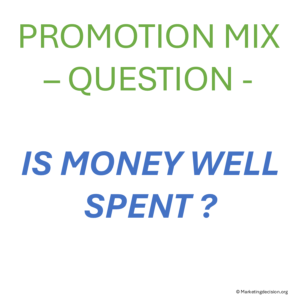
Yet the essential questions remain the same:
Which programs are most effective?
Are objectives being met?
Is the promotion budget wisely invested?
Where are the opportunities for improvement?
A well-structured portfolio of programs, each with a clear purpose, budget, and ownership, enables better coordination and informed decision-making.
When teams use the “Why, What, and How” structure, they gain a shared framework for planning, assessing, and communicating their efforts.
By continuously reviewing objectives and results, companies ensure that their promotion mix remains effective, adaptive, and aligned with evolving customer expectations.
The following sections introduce key tools and chapters that expand on this topic in more depth.
© marketingdecision.org
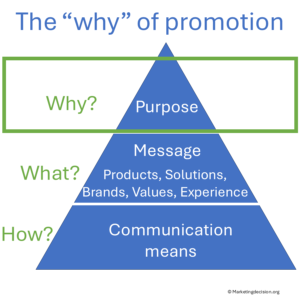 This chapter expands on how purpose and needs drive promotional decisions before defining objectives and means.
This chapter expands on how purpose and needs drive promotional decisions before defining objectives and means.
The “Why, What, and How” approach outlined on this site is a powerful tool for discussing marketing activities. This is particularly true for promotion and communication activities, where it is essential to articulate needs, objectives, and means. With multiple communication objects – the brand, the products, and even the people – the “Why, What, and How” becomes a wonderful key to understanding and organizing marketing activities.
The “Why” is the domain of purpose and needs. It serves as the platform for internal communication and management discussions, even before considering budgets and means, which are addressed with the “What” and “How.”
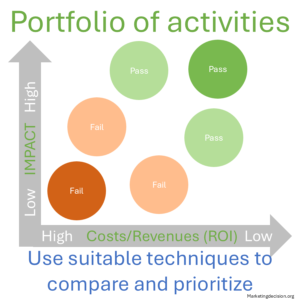 This section details how companies evaluate and compare their communication programs to allocate budgets effectively.
This section details how companies evaluate and compare their communication programs to allocate budgets effectively.
Companies often engage in numerous marketing initiatives, utilizing a variety of communication channels, including PR, direct internet communication, promotional activities, merchandising, and more.
To gain a comprehensive understanding of how priorities are set across various functions—mainly Marketing, Sales, Services, and others—it is crucial to develop a detailed portfolio of promotional and communication activities.
Clarity and transparency in promotion and communication programs offer multiple benefits, especially during periods of confusion about program prioritization. This leads to more effective budget allocation and better preparation for future investments.
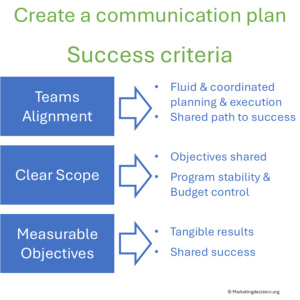 This final section shows how to transform objectives into measurable programs that align teams around company priorities.
This final section shows how to transform objectives into measurable programs that align teams around company priorities.
Before developing a communication plan, review why there is a need for this plan and what factors will measure success. Before diving into the “What” and “How” of communication, ensure the “Why” is well articulated and visible for participants, stakeholders, and sponsors. Discuss needs and identify key questions like:
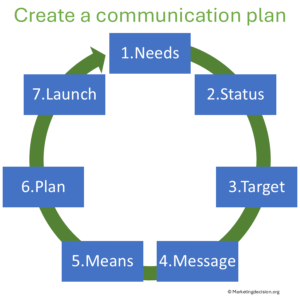 How can I increase brand visibility?
How can I increase brand visibility?Organizing a communication plan involves many components and dimensions. It can be seen as a one-time isolated effort or a complex coordination across multiple teams and communication supports, always aligned with company objectives and priorities.

This website focuses on the marketing mix and its key decision areas. Each category includes links to detailed methods, with some offering related tools available for purchase in our webshop. For easy navigation, use the main menu in the header to explore the marketing mix framework and methods. To go directly to the webshop, select the Shop menu in the header or click the link below. You can also browse by category.
© 2025 MARKETING DECISION SOLUTIONS. All Rights Reserved.